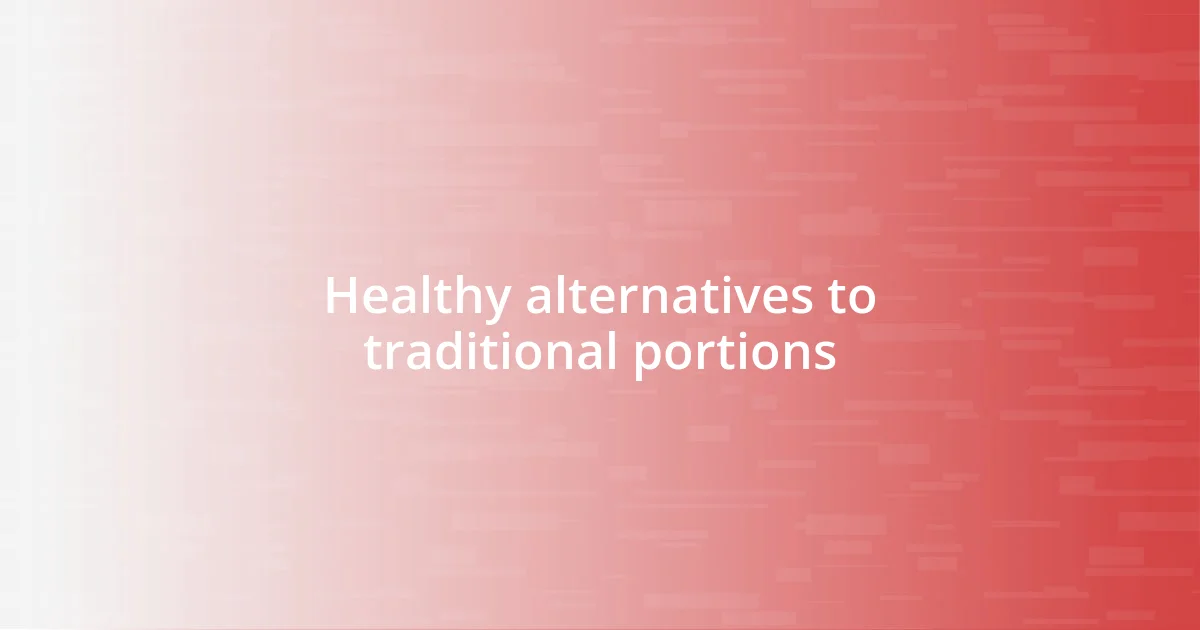Key takeaways:
- Fast food portion sizes have greatly increased over the decades, influencing eating habits and perceptions of hunger.
- The psychology behind large portions can lead to overconsumption due to visual cues, value perception, and social conditioning.
- Strategies for managing portion sizes include sharing meals, paying attention to hunger cues, using smaller dishes, and choosing healthier food options.

Understanding fast food portion sizes
When I think about fast food portion sizes, I can’t help but remember those days when I’d order a large fries, thinking I was getting a bargain. But the reality hit me when I realized that what I considered a “large” was actually enough to feed two people. Isn’t it surprising how our perception of what’s normal has shifted so dramatically?
Portion sizes in fast food restaurants have ballooned over the years, and that influences our eating habits significantly. One day, I stood in line, watching a young family order a meal that came with fries and sodas so large they didn’t fit in my memory of what a kid’s meal used to look like. It made me wonder: are we really that much hungrier, or have we just adapted to this oversized norm?
Sometimes, I catch myself reflecting on how misaligned these portion sizes are with nutritional guidelines. When I see a burger that’s practically the size of my plate, I think about what it means for my health. It’s worth asking—are we valuing quantity over quality at the risk of our well-being? Understanding these portion sizes isn’t just about what fills us up; it’s about making conscious choices for a healthier lifestyle.

Historical context of portion sizes
Portion sizes have undergone a remarkable transformation over the last few decades. I can’t help but reflect on my childhood experiences—when a “regular” size meant a modest helping, rather than today’s gargantuan servings. For instance, my family would share a single order of fries on a road trip, and it felt like a feast. Now, it’s almost laughable to think that I’m served what feels more like an entire meal.
Historically, fast food began with smaller, standardized portions, designed to appeal to the masses without overwhelming them. I remember reading about the original McDonald’s menu, which offered simple, smaller-sized items. They were adequate for satisfying hunger without turning it into an overindulgence. This shift in portion sizes has essentially redefined our comfort levels—what used to be considered generous is now simply the norm.
With the rise of the supersized mentality in the 1980s and 1990s, I’ve often pondered the psychological impact this has on us. Fast food marketing cleverly plays on our desire for value and satisfaction, making it difficult to resist those enticing offers. I recall a time when I succumbed to a promotion for a “meal upgrade,” which led me to consume more than I planned, all for the sake of a few extra fries. How often do we find ourselves eating not out of hunger, but merely because larger sizes are presented as a better deal?
| Decade | Typical Portion Size |
|---|---|
| 1960s | Small hamburger (2.5 oz) |
| 1980s | Regular fries (3 oz) |
| 1990s | Large fries (6 oz) |

Psychology behind large portions
I find it intriguing how our brains are wired to respond to larger portions. It’s interesting to reflect on my personal experiences when I’ve encountered massive servings; I often felt an overwhelming urge to finish everything on my plate, even if I wasn’t hungry anymore. This is not just a personal quirk—research suggests that the more food we’re presented with, the more we tend to eat, largely driven by visual cues.
Here are some thoughts on the psychology behind it:
- Visual Cue Theory: Our eyes often dictate our appetites; once we see a large portion, our brain signals that it’s a reasonable amount to consume.
- Value Perception: When we perceive larger sizes as better deals, we’re often influenced to order more food than we actually need, leading to overconsumption.
- Social Conditioning: I’ve noticed that group dining experiences can amplify this effect—a larger portion seems to signal abundance and can pressure individuals to match or exceed that consumption.
The connection between portion sizes and our psychological motives is deeply rooted in our eating habits. I remember visiting a fast food place with friends, where we all ordered ‘just a little extra.’ By the end of the meal, we were uncomfortably full, realizing that our eyes had far exceeded our stomach’s actual needs. It’s a reminder of how our environments can influence our choices and lead us towards eating more than what’s necessary.

Strategies for managing portion sizes
One effective strategy for managing portion sizes is to consciously decide to share meals or split larger servings with a friend. I often find that doing this not only saves a few bucks but also reduces my overall intake. It’s funny, but I usually enjoy my meals more when I focus on the conversation rather than the quantity on my plate. Have you ever noticed how sharing can enhance your dining experience?
Another approach I’ve adopted is to pay attention to my hunger cues before and during meals. When I find myself reaching for more food, I pause to ask if I’m still hungry or just eating out of habit. I vividly remember a time when I excused my second helping by convincing myself there was “just a little left.” Reflecting on that, I realize it’s crucial to differentiate between true hunger and the temptation to clear my plate.
Lastly, I recommend using smaller plates and bowls when eating. This little trick creates an illusion of a fuller plate without actually consuming more food. I’ve started doing this at home, and surprisingly, my mind doesn’t panic over perceived scarcity. In fact, it feels rewarding to savor smaller portions, which often leads to a greater appreciation of the meal. How about you? Have you tried similar tactics?

Healthy alternatives to traditional portions
One of the healthiest alternatives I’ve discovered is opting for salad or vegetable-based sides instead of the usual fries. I remember a time when I decided to swap my typical side at a burger joint. The vibrant colors and crunch of the fresh vegetables not only elevated my meal but also left me feeling satisfied without the heaviness that often comes with traditional portions. It’s amazing how simple changes can revitalize the dining experience, don’t you think?
Another strategy I’ve embraced involves choosing grilled or baked proteins over fried ones. One day, while ordering at a fast food chain, I chose a grilled chicken sandwich instead of the crispy version. That small switch made a significant difference, both in the meal’s caloric density and how I felt afterward. I was energized rather than lethargic. Have you ever felt that exhilarating lift when you make a healthier choice?
Lastly, I’ve found joy in experimenting with homemade alternatives. Preparing my own versions of fast food favorites has been both fulfilling and nutritious. I often make baked sweet potato fries to pair with my sandwiches, and they are full of flavor without all the excess calories. Honestly, there’s something genuinely satisfying about knowing exactly what’s in your food. Have you ever considered trying your hand at recreating your favorite fast food dishes?

Making informed choices at restaurants
Making informed choices at restaurants starts with reviewing the menu before you arrive. I can’t stress enough how this simple practice has changed my dining experiences. One evening, I casually browsed the menu online and was pleasantly surprised to spot a quinoa salad packed with greens and nuts. Choosing something like that not only felt like a healthier option but also left me excited about the meal ahead. Have you ever felt that buzz of anticipation when opting for something both delicious and nutritious?
Paying attention to portion sizes directly impacts how I enjoy my meals at restaurants. I vividly remember a time when I opted for a shareable appetizer instead of an entree. It felt liberating to break the norm and savor a few bites while chatting with friends. This choice left me feeling satisfied without the overwhelming heaviness that often comes with large portion sizes. Have you tried ordering appetizers as your main course?
Being mindful of the dining environment plays a significant role in informed choices, too. I often take a moment to step back and notice the hustle and bustle around me. One time, I sat at a cozy corner table with soft lighting, which instantly changed my perspective. Instead of mindlessly chowing down, I found myself truly appreciating the flavors of my dish. There’s something to be said about slowing down and experiencing your meal fully—what do you think?















